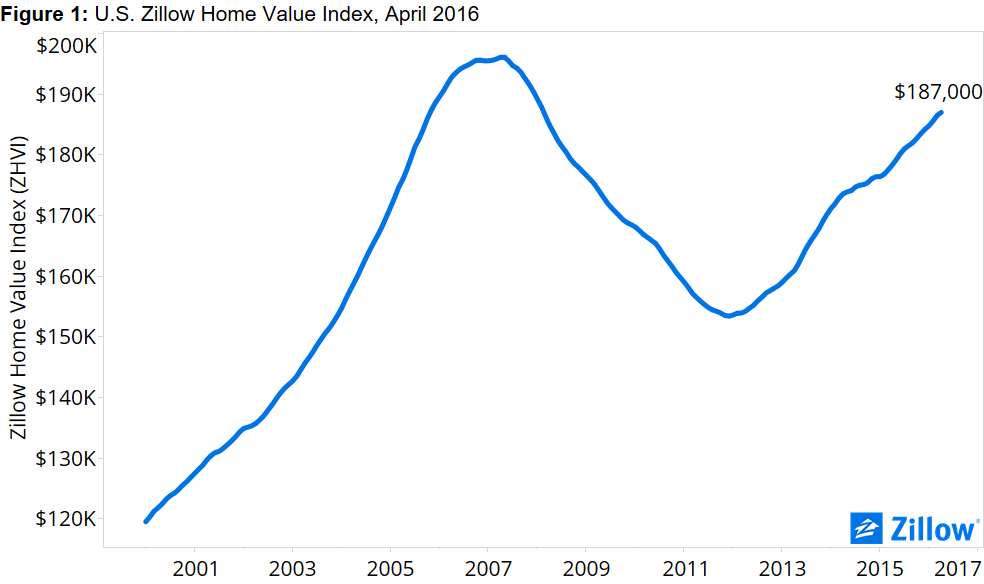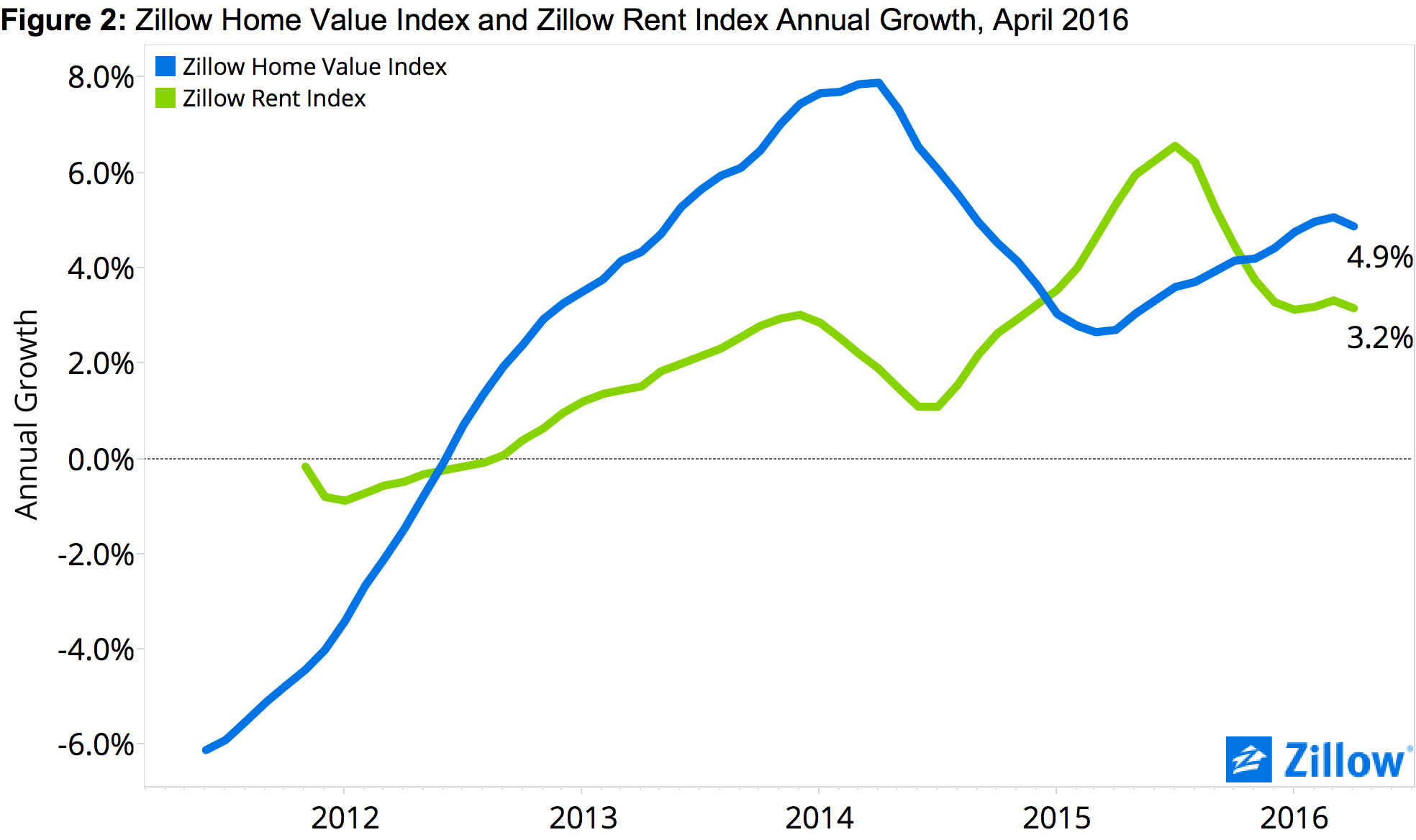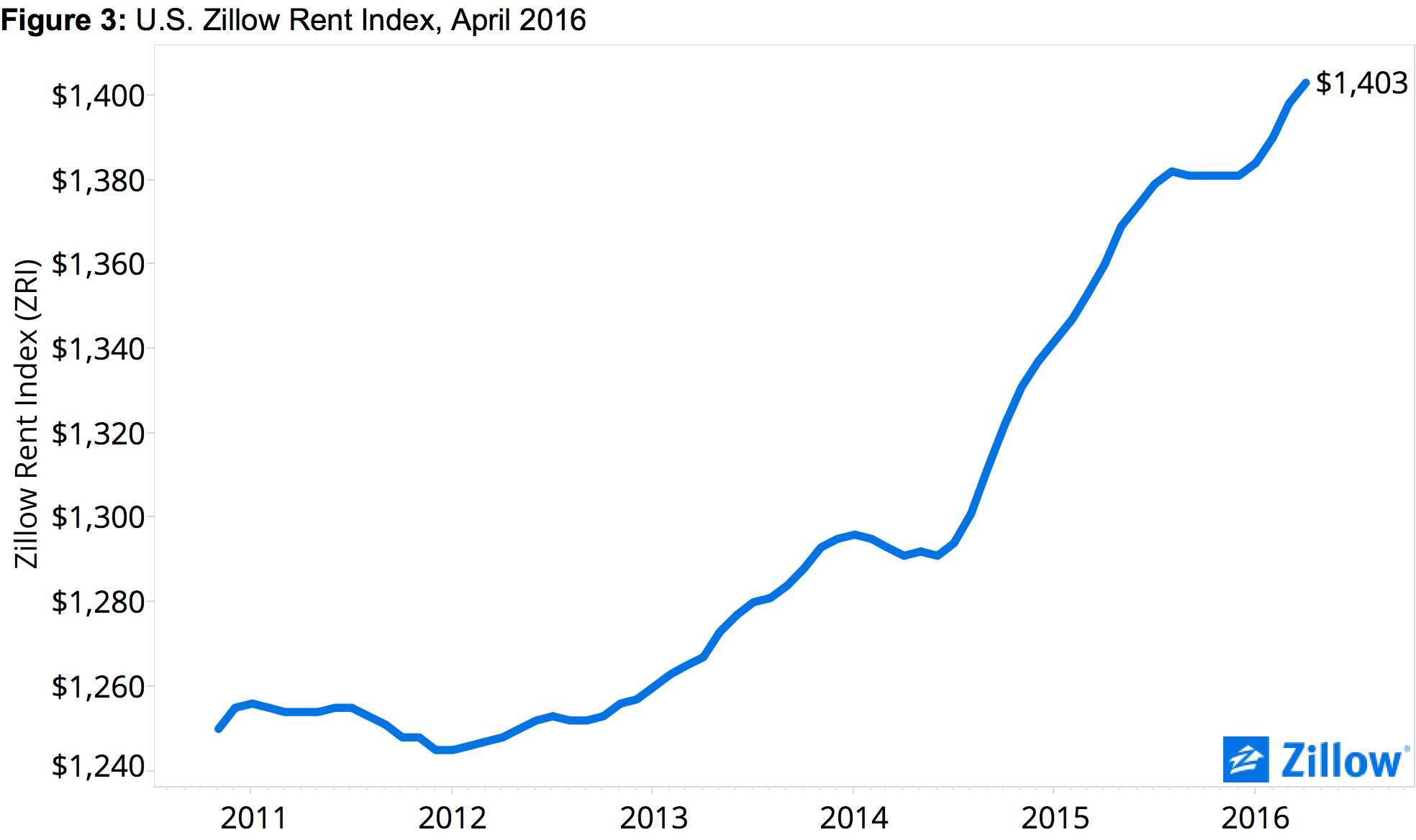April Market Report: Home Values Continue Their Feverish Climb Amid Tight Inventory
After having slowed their growth a bit in 2015, median home values are once again climbing at a faster than normal pace. In fact, home values are appreciating faster than many experts had expected, rising almost 5 percent over the past year, according to the April Zillow Real Estate Market Reports to a Zillow Home Value Index of $187,000.
- Low inventory, stronger wage growth, and low mortgage rates have been pushing home values higher than predicted.
- Nationally, home values rose 4.9 percent over the past year to a median home value of $187,000.
- There are 3.4 percent fewer homes for sale in the U.S. than a year ago and 7.8 percent fewer entry-level homes for sale in the U.S. than a year ago.
 After having slowed their growth a bit in 2015, median home values are once again climbing at a faster than normal pace. In fact, home values are appreciating faster than many experts had expected, rising almost 5 percent over the past year, according to the April Zillow Real Estate Market Reports to a Zillow Home Value Index of $187,000.
After having slowed their growth a bit in 2015, median home values are once again climbing at a faster than normal pace. In fact, home values are appreciating faster than many experts had expected, rising almost 5 percent over the past year, according to the April Zillow Real Estate Market Reports to a Zillow Home Value Index of $187,000.
The Zillow Home Value Forecast was 2 percent from April 2015 to April 2016, and the Zillow Home Price Expectations Survey panel of economists and industry experts had also expected growth to slow a bit when they predicted home value appreciation from December 2015 to December 2016.
While we had seen a slowdown in home value growth in early 2015 and through the middle of the year, towards the end of 2015 and into 2016 home value appreciation had once again picked up speed, to now grow almost 3 percentage points faster than initially expected.
 This strong home value growth, especially in some markets across the nation is in large part due to very tight for-sale inventory, in addition to high housing demand, stronger wage growth amid a robust labor market, and historically-low mortgage rates. The number of homes for sale has been steadily declining since the beginning of the year, and entry-level homes have been hit the hardest. While national inventory levels are down 3.4 percent from a year ago, the number of less expensive and often entry-level homes for sale is down almost 8 percent over the past 12 months. This has been making it especially hard for first-time home buyers to transition away from renting to being homeowners.
This strong home value growth, especially in some markets across the nation is in large part due to very tight for-sale inventory, in addition to high housing demand, stronger wage growth amid a robust labor market, and historically-low mortgage rates. The number of homes for sale has been steadily declining since the beginning of the year, and entry-level homes have been hit the hardest. While national inventory levels are down 3.4 percent from a year ago, the number of less expensive and often entry-level homes for sale is down almost 8 percent over the past 12 months. This has been making it especially hard for first-time home buyers to transition away from renting to being homeowners.
Home Values and Inventory Levels
The April 2016 Zillow Real Estate Market Report covers over 500 metropolitan and micropolitan areas. The median U.S. home value was $187,000 in April, up 0.3 percent from March and up 4.9 percent from April 2015. Annual appreciation in home values peaked at 7.9 percent in March and April 2014, and the annual rate of appreciation declined thereafter until it started to once again strengthen in the second half of 2015. Home values remain almost 5 percent below their April 2007 peak of $196,100.
Inventory levels continue to remain incredibly tight, with national for-sale inventory down 3.4 percent from a year ago. The for-sale market has the least amount of inventory among homes priced in the bottom third of all homes, where there were almost 8 percent fewer homes on the market in April than there were a year ago. Homes valued in the top-third of all homes are more readily available, as inventory among this price tier is down only slightly (-0.3%) from last year’s levels.
Markets with the tightest inventory have some of the fastest rising home values. Over the past two years, Portland has seen an almost 40 percent decrease in the number of homes for sale, with home values up 15 percent over the past 12 months. Similar patterns hold true in hot markets like Dallas, where overall inventory is down 21 percent from last year and homes values are rising almost 13 percent annually; and Seattle, where overall inventory is down 21% from last April and homes values are up almost 12 percent from last year.
These current market conditions are making it much more difficult for first-time home buyers to break into the homeownership market. Move-up buyers are having a slightly easier time locating available inventory, as available for-sale homes are more available at higher price points, especially in the high-end, luxury markets across the country. Inventory is improving much more quickly in these two markets due to high-end construction, with the number of homes for sale close to hitting positive growth.
Rents
 U.S. rents grew by 3.2 percent year-over-year in April, to a Zillow Rent Index (ZRI) of $1,403. As home value appreciation has gained some steam over the last few months, rents have slowed their pace of appreciation, down from a pace of close to 7 percent annual appreciation in mid-2015. This more sustainable rate of 3.2 percent annual appreciation, which is in line with historical averages, will also give incomes more of a chance to catch up to rents, as rental affordability has been plaguing a majority of markets across the country.
U.S. rents grew by 3.2 percent year-over-year in April, to a Zillow Rent Index (ZRI) of $1,403. As home value appreciation has gained some steam over the last few months, rents have slowed their pace of appreciation, down from a pace of close to 7 percent annual appreciation in mid-2015. This more sustainable rate of 3.2 percent annual appreciation, which is in line with historical averages, will also give incomes more of a chance to catch up to rents, as rental affordability has been plaguing a majority of markets across the country.
The Portland metro experienced the highest annual rent appreciation among large markets, up almost 10 percent since April 2014. Other markets with continued high rates of rental appreciation were San Francisco (9 percent), Seattle (8.5 percent) San Jose (8.1 percent) and Denver (7.3 percent).
Looking Ahead
Zillow expects U.S. home values to grow another 2.4 percent through April 2017, according to the Zillow Home Value Forecast. The struggle for home shoppers will continue this summer, with tight inventory, bidding wars and rapidly rising home values. New construction has been sluggish over the past year with new home sale numbers coming in at about half as many homes as should be sold in a more normal market and there still aren’t enough homes on the market to keep up with the high demand from every type of home buyer at all price points. In addition, we expect this summer’s selling season’s borders to be most likely blurred again as many buyers are left without homes and will need to keep searching.

 After having slowed their growth a bit in 2015, median home values are once again climbing at a faster than normal pace. In fact, home values are appreciating faster than many experts had expected, rising almost 5 percent over the past year, according to the April Zillow Real Estate Market Reports to a Zillow Home Value Index of $187,000.
After having slowed their growth a bit in 2015, median home values are once again climbing at a faster than normal pace. In fact, home values are appreciating faster than many experts had expected, rising almost 5 percent over the past year, according to the April Zillow Real Estate Market Reports to a Zillow Home Value Index of $187,000. This strong home value growth, especially in some markets across the nation is in large part due to very tight for-sale inventory, in addition to high housing demand, stronger wage growth amid a robust labor market, and historically-low mortgage rates. The number of homes for sale has been steadily declining since the beginning of the year, and entry-level homes have been hit the hardest. While national inventory levels are down 3.4 percent from a year ago, the number of less expensive and often entry-level homes for sale is down almost 8 percent over the past 12 months. This has been making it especially hard for first-time home buyers to transition away from renting to being homeowners.
This strong home value growth, especially in some markets across the nation is in large part due to very tight for-sale inventory, in addition to high housing demand, stronger wage growth amid a robust labor market, and historically-low mortgage rates. The number of homes for sale has been steadily declining since the beginning of the year, and entry-level homes have been hit the hardest. While national inventory levels are down 3.4 percent from a year ago, the number of less expensive and often entry-level homes for sale is down almost 8 percent over the past 12 months. This has been making it especially hard for first-time home buyers to transition away from renting to being homeowners. U.S. rents grew by 3.2 percent year-over-year in April, to a Zillow Rent Index (ZRI) of $1,403. As home value appreciation has gained some steam over the last few months, rents have slowed their pace of appreciation, down from a pace of close to 7 percent annual appreciation in mid-2015. This more sustainable rate of 3.2 percent annual appreciation, which is in line with historical averages, will also give incomes more of a chance to catch up to rents, as
U.S. rents grew by 3.2 percent year-over-year in April, to a Zillow Rent Index (ZRI) of $1,403. As home value appreciation has gained some steam over the last few months, rents have slowed their pace of appreciation, down from a pace of close to 7 percent annual appreciation in mid-2015. This more sustainable rate of 3.2 percent annual appreciation, which is in line with historical averages, will also give incomes more of a chance to catch up to rents, as